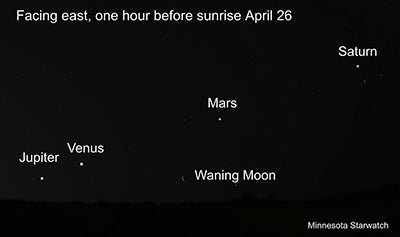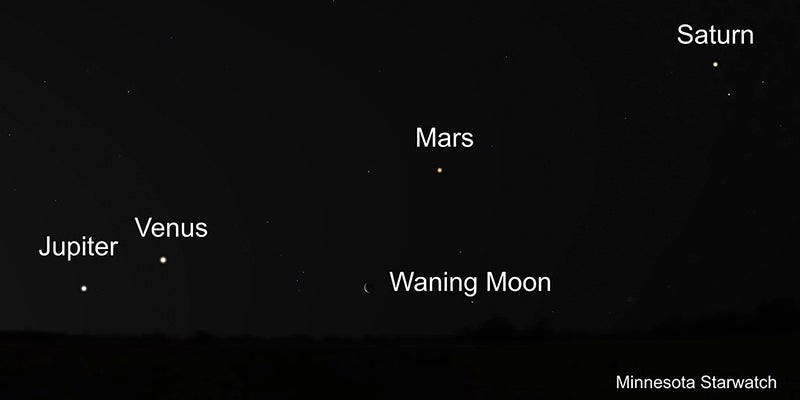StarWatch: The planets take over the April skies
Published 5:48 pm Tuesday, April 5, 2022
|
Getting your Trinity Audio player ready...
|
By Deane Morrison
As April opens, the stage is set for some serious planetary action in the morning sky.
On April Fool’s Day, Venus, Saturn and Mars sat close to each other above the eastern horizon, almost equally spaced and in that order from left to right. But don’t be fooled; Saturn is rapidly gaining altitude, and on the 5th it passed less than a moon width above Mars. As the month goes on, the three planets spread farther and farther apart while staying in a line. On the 25th, Mars will be exactly midway between Saturn and Venus.

Photo provided
Around the 21st, Jupiter appears to the lower left of Venus; the gap between them narrows rapidly. Try looking on the 25th or 26th, when a waning moon appears with the planets, or on the 30th or May 1, when Jupiter passes above Venus. But whichever day(s) you choose, it’s best to get out just as day starts to break, to ensure all the expected objects have risen but none have yet been swallowed by the sun’s foreglow.
In the evening sky, the spring constellation Leo, the lion, is high in the southeast to south at nightfall. Leo’s brightest star, Regulus, anchors a backward question mark of stars called the Sickle, which outlines the lion’s head. East of the Sickle shines a triangle of stars marking the hindquarters and tail.
Look between Regulus and Pollux, the brighter Gemini twin, for the Beehive star cluster. It’s slightly closer to Pollux, and you may need a star map or binoculars. The Beehive is also called Praesepe, Latin for “manger.” Framing the cluster are two stars called Aselli, or asses, that feed at the manger.
April’s full moon crosses the sky the night of the 16th. It follows Spica, the brightest star in Virgo, the maiden. Virgo is large and rather dim, but you may notice Corvus, the crow, an irregularly shaped four-sided figure just west of Spica.
The University of Minnesota’s public viewings of the night sky at its Duluth and Twin Cities campuses have been curtailed due to the COVID-19 pandemic. For more information, see:
• Duluth, Marshall W. Alworth Planetarium: www.d.umn.edu/planet
• Twin Cities, Minnesota Institute for Astrophysics: www.astro.umn.edu/outreach/pubnight
• Check out astronomy programs, free telescope events, and planetarium shows at the
• University of Minnesota’s Bell Museum: www.bellmuseum.umn.edu/astronomy
• Find U of M astronomers and links to the world of astronomy at: www.astro.umn.edu



